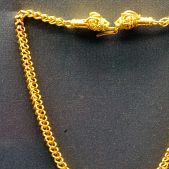
Vanity: Jewelry stories from the Cyclades
A luxurious and glittering book, like the world of jewelry, was presented at the renovated Fethiye Mosque in the Roman Agora. This is the catalog of the periodical exhibition “Vanity-Jewelry stories from the Cyclades”, carried out by the Ephorate of Antiquities of the Cyclades for more than a year at the Archaeological Museum of Mykonos. The groundbreaking exhibition, which was discussed very much in terms of both conception and presentation, was designed in such a way that it can travel to other countries. Thus, at the event, Pompey’s Archbishop of Antiquities, Massimo Osanna, who was one of the speakers, made known, that Pompey will welcome the Vanity exhibition.
The catalog follows the originality of the exhibition, as it consists of two distinct parts, which open at the opposite manner. One part includes full-page photographs of ancient jewelry and the other information given by the 40 authors of the publication. The texts are in Greek and in English. The catalog is accompanied by a large “case” with corresponding size tabs, which on one side show the pictures from the contemporary works of the exhibition that were created by 12 promising Greek designers inspired by the antiquities and on the other side the bilingual reference to them .
Diadems, hair rings and earrings, anklets and armbands, fibulas and pins, finger rings and bracelets made from shells, bone and ivory, common and semi-precious stones, glass, faience, and coral as well as of bronze, silver and gold reveal human beings’ eternal need to adorn their body, hair and clothing to draw attention and beguile, to stand out, to assert themselves, to attract auspicious powers, or to avert evil. From among these artefacts’ multiple meanings, it was decided to highlight their role as evidence of human vanity and coquetry, thus stressing their timeless function and linking them with contemporary humans. All the items − which include pieces worn for purely decorative purposes as well as offerings discovered at sanctuaries such as Delos, among others − are made of precious or semi-precious materials and indicate power, femininity or, in fact, vanity, but they are all a testament to the artistry of local craftsmen and its evolution through the ages.
“Through this exhibition, the ephorate’s aim, besides everything else, was to relaunch the renovated Archaeological Museum of Myconos as the center of the Cycladic islands, as well as a place to visit for those coming to the island,” said ephorate chief Dimitris Athanasoulis, who is also the exhibition’s coordinator. The renovation of the Myconos museum is a part of a broader effort to upgrade museums in the Cyclades and turn them into state-of-the-art showcases that will do justice to the historical and archaeological wealth that they house and address the needs of the modern visitor.
At the “Vanity” exhibition, visitors were able to browse a large number of impressive artifacts dating as far back as the 4th millennium BC, many of which are going on display for the first time. All the items, which include pieces worn for purely decorative purposes as well as offerings discovered at sanctuaries such as Delos, among others, are made of precious or semi-precious materials and illustrate the exceptional techniques of local goldsmiths.
The local community has played a role in the exhibition’s organization through sponsorships and donations, while the show is taking place with the support of the Municipality of Myconos.



















